QR Zones of Green Cay Wetlands Boardwalk
Back to Introduction

 Follow this link to see a video presentation of this zone!
Follow this link to see a video presentation of this zone!
As you begin your walk, you first come upon a shallow marsh characterized by a wide diversity of emergent and floating-leaved plant species. In nature, emergent marsh areas represent transitional zones between dry land and water. The diverse combination of emergent marsh plants serve as important habitat for many wetland bird species and increases the amount of nutrients removed from the water. The plants, insects, and fish found in the shallow water of this zone also serve as a key food source for the animals seen here.
Plants: Spatterdock, American White Waterlilly, Big Floating Heart, Lotus.
Animals: Coots, Common Gallinule, Pied-Billed Grebe, Turtles, Frogs, Water Snakes.
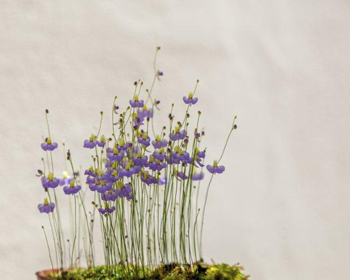
BLADDERWORT - Free-floating annual plants that lack roots but have flowers on erect stems above the water. The entire floating plant is only about 8 inches tall. Flowers emerge above the surface and are yellowish with 3-lobes and a spur underneath. Underwater the leaf branches or petioles are fleshy and inflated with air which allows them to float. Leaves are whorled with 4 to 10 lateral leaves which fork often giving them a very delicate capillary appearance. Bladderworts are unique in that the underwater leaves bear small oval “bladders” that trap and digest small aquatic creatures. Bladderworts are usually found in quiet shallow, acidic waters and can form dense mats.

WHITE IBIS - Found from the mid-Atlantic and Gulf Coast of the United States south through most of the tropics. This particular ibis is a medium-sized bird with an overall white plumage, bright red-orange down-curved bill and long legs, and black wing tips that are usually only visible in flight. Males are larger and have longer bills than females. Their diet consists primarily of small aquatic prey, such as insects and small fishes. Crayfish are its preferred food in most regions; however, it can adjust its diet according to the habitat and prey abundance. It is a tactile, non-visual forager, whose main foraging behavior is probing with its beak at the bottom of shallow water to feel form, and to capture its prey.
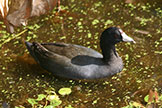
COOTS - Medium-sized, crane-like birds that are members of the Rallidae (rail) family. Coots have predominantly black plumage, and—unlike many rails—they are usually easy to see, often swimming in open water. They are close relatives of the moorhen. Coots have prominent frontal shields or other decoration on the forehead, with red to dark red eyes and colored bills. Many, but not all, have white on the under tail. The featherless shield gave rise to the expression "as bald as a coot," which the Oxford English Dictionary cites in use as early as 1430. Like other rails, they have long, lobed toes that are well adapted to soft, uneven surfaces. Coots have strong legs and can walk and run vigorously. They tend to have short, rounded wings and are weak fliers, though northern species nevertheless can cover long distances.

PIED-BILLED GREBE - A small diving bird with a chicken-like bill, the Pied-billed Grebe is common on lakes and ponds across North America. It is rarely seen flying and prefers to sink out of sight when danger threatens. The Pied-billed Grebe is rarely seen in flight. It prefers to escape predators by diving, and it migrates at night. However, it can fly, and stray individuals have reached Hawaii and Europe. Although it swims like a duck, the Pied-billed Grebe does not have webbed feet. Instead of having a webbing connecting all the toes, each toe has lobes extending out on the sides that provide extra surface area for paddling.
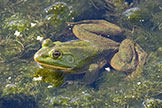
PIG FROG - Native to Florida and found throughout lakes or cypress swamps and marshes that are heavy with vegetation. Although the Pig Frog is not currently listed as threatened, managed or imperiled by FWC, there is concern that their population could be declining due to this species being a staple in the frog leg industry. The pig frog is green or grey-green in color with brown or black blotching. It has fully webbed feet, a sharply pointed nose and large tympana (eardrums). As its name suggests, the call of the pig frog sounds much like a pig grunting. They can grow to be up to 6 inches in length, making it the largest species of native frog in FL and often causing this frog to be mistaken for a bullfrog. The pig frog is nocturnal and pursues a varied diet of beetles, dragonflies, crayfish, and other aquatic invertebrates with the fish or other amphibian.
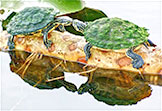
TURTLES – Green Cay is home to a variety of turtles such as the Red-Eared Slider, Florida Softshell, Mud, Red-Bellied and Peninsula Cooter. A turtle’s shell is made of a protein called keratin. This is the same protein that makes up our hair and fingernails. The shell grows with the turtle throughout their life. When the turtle grows scutes are shed. If there are ridges on the shell or tail, they are called keels. Keels and scutes create the hard, armor-like texture of the shell that provides protection for the turtle. The top part of the shell is called the carapace, the bottom is called the plastron, and the connection between the two is called the bridge.
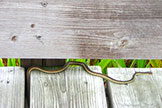
SNAKES - Many species of snakes can be seen swimming through the grasses of the shallow marsh water hunting for food. Most notably: the Peninsular Ribbon Snake and the Brown Banded Water Snake. The Peninsular Ribbon Snake (pictured) is a unique species in two ways: first, they are one of the very few snake species that gives birth to live young and second, they eat only cold blooded prey such as fish, tadpoles, and small invertebrates. The Brown Banded Water Snake can oftentimes be mistaken for the venomous Water Moccasin. Neither the Ribbon nor the Water Snakes are venomous and are important members of the marsh ecosystem food web, being both a predator and an important food source for large wading birds such as herons.
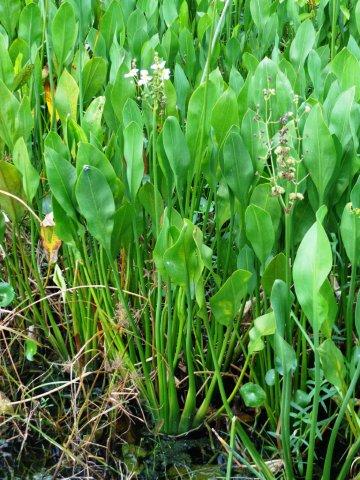
ARROWHEAD - An emersed plant. It's large leaves and conspicuous flowers make it easy to find in the wild. It grows commonly in swamps, ditches, lakes, and stream margins. Arrowhead is also called duck potato because of its potato-like, underground corms that sometimes form. Duck potato has large, firm, lance-shaped leaves, which are typically four inches wide and up to two feet long. Also called Duck Potato.
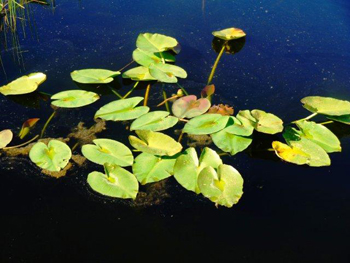
SPATTERDOCK - Spatterdock is a large plant whose leaves are often floating. Spatterdock commonly occurs in ponds, lakes and sluggish streams and blooms from spring to summer. Spatterdock has large heart-shaped leaves, usually with wavy margins. Spatterdock floating leaves are attached to long, stout stems which arise from large, spongy rhizomes. Spatterdock submersed leaves are very thin, attached at the bottom rhizomes. Spatterdock flowers are yellow and "half-opened" at or above the water surface. Flowers are attached to thick round stems that are often six feet long.
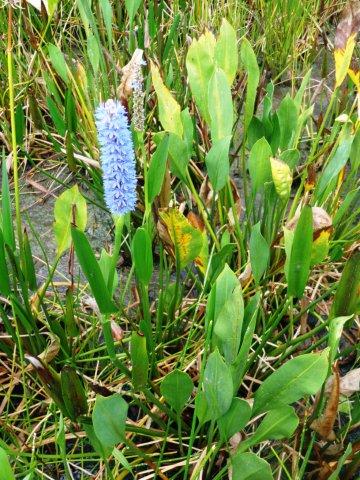
PICKERELWEED - A very common and widely recognized native. It occurs throughout Florida and flowers year-round. Pickerelweed typically grows to about 2 or 3 feet tall. Its leaves are large (up to 5 inches wide) and are usually twice as long. Leaf shapes are variable, but are usually lance-shaped. They may have either a distinctly heart-shaped face or a rounded face. The easiest way to recognize pickerelweed is by its spike of violet-blue flowers. Uncommonly the flowers are white. Many small individual flowers form this flowering spike. The leaf and the flower spike arise from the same stem. Without flowers, pickerelweed can be confused with Sagitarria latifolia, common arrowhead. To distinguish between the two, look at the leaf lobes. Common arrowhead has pointed lobes on its arrow-shaped leaves. Pickerelweed has heart-shaped or rounded lobes on its lance-shaped leaves. Pickerelweed is a common native of Florida. It has a large flowering spike of violet blue or white flowers, heart-shaped leaves with rounded lobes, and its large leaves are about twice as long as they are wide.

COMMON GALLINULE (also known as the "swamp chicken") - is bird species in the Rallidae family. It lives around well-vegetated marshes, ponds, canals and other wetlands. The Moorhen is a distinctive species, with dark plumage apart from the white undertail, yellow legs and a red frontal shield. The birds are territorial during breeding season. The nest is a basket built on the ground in dense vegetation. Laying starts in spring, between mid-March and mid-May in N hemisphere temperate regions. About 8 eggs are usually laid per female early in the season; a brood later in the year usually has only 5–8 or fewer eggs. Nests may be re-used by different females. Incubation lasts about three weeks. Both parents incubate and feed the young. These fledge after 40–50 days, become independent usually a few weeks thereafter, and may raise their first brood the next spring.
Green Cay Nature Center and Wetlands is owned and operated by the
Palm Beach County Parks and Recreation Department and the
Water Utilities Department.